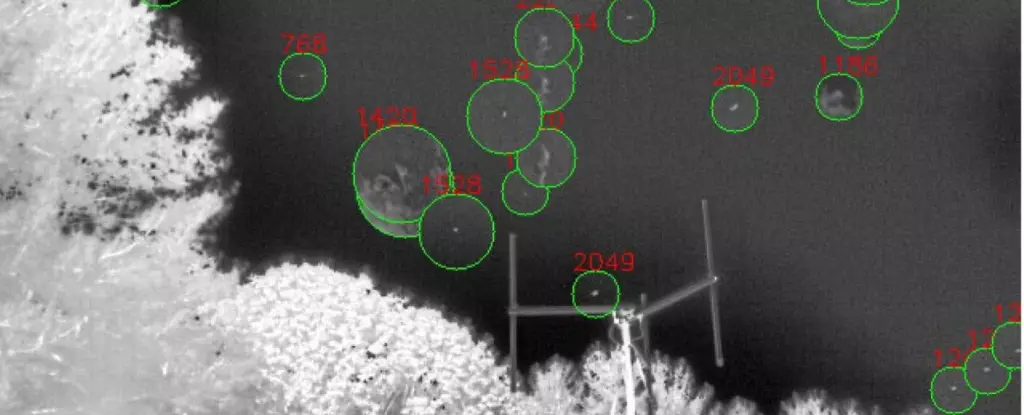For decades, discussions surrounding Unidentified Aerial Phenomena (UAP) have danced in the realms of speculation, conspiracy, and intrigue. In 2021, the Office of the Director of National Intelligence (ODNI) provided a glimpse of what lies behind the curtain of classified data, sparking heightened interest in what these enigmatic objects represent. While subsequent reports from the Department of Defense through the All-domain Anomaly Resolution Office (AARO) have provided some insights, an evident void remains: scientifically rigorous public data to analyze this phenomenon. This gap has laid the groundwork for innovative approaches, including the groundbreaking study led by the Harvard-Smithsonian Center for Astrophysics and the Galileo Project.
The Dalek Initiative: A Bold Proposal
At the heart of this research is a novel observational mechanism known as the All-Sky Infrared Camera, affectionately named Dalek, a nod to popular science fiction. This creative choice reflects not just a homage to cultural touchstones, but it also symbolizes the ambitious mission to penetrate the veil of ignorance surrounding UAPs. The project, spearheaded by Laura Domine and a collaborative group of researchers, seeks to harness cutting-edge technology to unearth clues about potential extraterrestrial spacecraft.
The vision laid out in their proposal is ambitious and multifaceted, echoing the recommendations made by NASA in a recent independent study. By proposing purpose-built sensors capable of rapid adjustments—on millisecond scales—the team hopes to enrich the existing data landscape, ideally paving the way for a comprehensive understanding of UAP phenomena. The proposed observatory aims to emulate a multi-sensory approach to data collection, targeting not just visual characteristics but also auditory cues and other vital metrics.
Collaborative Efforts and Technological Advancements
Professor Avi Loeb, a notable figure in astrophysics, champions the Galileo Project and underscores its commitment to public science. His assertion that the sky is not classified resonates deeply in an era where information is often shrouded in secrecy. The project’s three observatories, located in Massachusetts, Pennsylvania, and Nevada, are designed to detect about 100,000 objects monthly, collectively amassing a trove of data. By employing advanced machine-learning algorithms, the team is revolutionizing how we sift through collected information, distinguishing mundane flights from those that may defy known aerial dynamics.
The reliance on tools like the You Only Look Once (YOLO) model for object detection and the Simple Online and Real-time Tracking (SORT) algorithm for trajectory analysis marks a significant leap forward. It allows researchers to identify anomalies against established baselines, creating a new standard in UAP evaluation. This systematic methodology allows them to analyze vast datasets, identifying approximately 80,000 trajectories marked as outliers during the observatory’s initial operational phase.
Tackling the Ambiguity of Anomalies
Despite the unprecedented data collection, not all findings yield conclusive insights. The team reported nearly 144 ambiguous trajectories that defy easy classification, suggesting that the complexities associated with UAPs may be far greater than previously suspected. This acknowledgment of uncertainty is refreshing in the scientific community, where definitive answers often overshadow the exploratory nature of research.
Loeb’s commentary emphasizes the importance of distance measurement in conclusively classifying detected objects. Currently, the ambiguity surrounding trajectories challenges researchers, but the hope of employing triangulation—utilizing multiple sensors to determine distance—opens avenues for future discoveries. If successful, such methods could yield insights into object velocity and characteristics, potentially illuminating the mysteries behind several reported UAP incidents.
A Future Filled with Potential
The ultimate goal, as expressed by Loeb, is intrinsically tied to the romantic notion of discovering technosignatures—signs of advanced civilizations. This ambition, though steeped in scientific rigor, taps into the innermost desires of humanity to explore and understand the unknown. The prospect of unearthing even a singular case exhibiting extraterrestrial capabilities would not only redefine human comprehension of technology but also expand our place in the cosmic tapestry.
In an age where scientific discoveries reshape our worldview nearly every day, the pursuit of understanding UAPs through the Dalek initiative stands out as a testament to innovation and perseverance. The path ahead is uncertain, marked by both challenges and tantalizing possibilities. Regardless of outcome, the engagement with the cosmos has begun in earnest, and with it, a revolution in how humanity perceives itself within the universe.


Leave a Reply